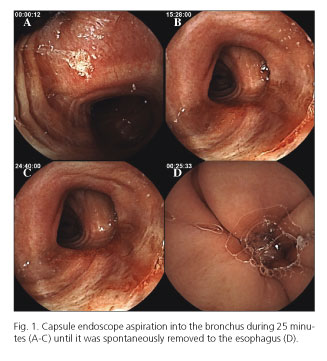Mi SciELO
Servicios Personalizados
Revista
Articulo
Indicadores
-
 Citado por SciELO
Citado por SciELO -
 Accesos
Accesos
Links relacionados
-
 Citado por Google
Citado por Google -
 Similares en
SciELO
Similares en
SciELO -
 Similares en Google
Similares en Google
Compartir
Revista Española de Enfermedades Digestivas
versión impresa ISSN 1130-0108
Rev. esp. enferm. dig. vol.108 no.9 Madrid sep. 2016
https://dx.doi.org/10.17235/reed.2016.4363/2016
LETTERS TO THE EDITOR
Asymptomatic bronchial aspiration of capsule endoscope: a significant complication
Key words: Capsule endoscopy. Small bowel. Aspiration.
Dear Editor,
Capsule endoscopy is a safe and well-tolerated procedure allowing the direct, non-invasive mucosal investigation of the small bowel. There are, however, few limitations.
Case Report
An 82-year-old man presented a four-month period of iron-deficiency anemia. No source of bleeding was obtained after conventional upper and lower endoscopy. Thus, video capsule endoscopy was indicated. Although the patient had not history of oropharyngeal dysphagia, swallowing of the capsule endoscope precipitated self-limited coughing. Twelve hours later fever, leucocytosis and dyspnea appeared, so that profilactic antibiotics were initiated. When the capsule endoscope was reviewed the device was located in the bronchial system (Fig. 1 A-C) and remained lodged in the carina for 25 minutes, throughout which the patient was asymptomatic. Passed this time, the capsule endoscopy moved spontaneously to the esophagus (Fig. 1D) and continued loading until the cecum. At this time, capsule endoscope bronchoaspiration was confirmed and antibiotic strategy was changed, improving respiratory symptoms.
Discussion
Capsule endoscopy is currently considered as a first line diagnostic tool for small bowel examination. It has been demonstrated to be an accurate, painless and well-tolerated procedure. However, although it is a safe technique, few adverse events have been published, being capsule aspiration one of them. Bronchoaspiration is an uncommon but dangerous capsule endoscopy-related adverse event, as the device can be retained in the airway until video visualization, resulting in potential respiratory failure (1). In some cases, it may be removed bronchoscopically (2). The incidence of capsule aspiration is very low (< 0.003%) (3), being in our experience the first time this complication arises out of 2,500 explorations. Therefore, real time viewing is recommended. Moreover, in patients with swallowing difficulties, capsule endoscope should be placed endoscopically in the duodenum to eliminate aspiration risk.
José Francisco Juanmartiñena-Fernández1,2, Ignacio Fernández-Urién1,2 and Juan José Vila-Costas1,2
Departments of 1Endoscopy and
2Digestive Diseases. Complejo Hospitalario de Navarra. Pamplona, Navarra. Spain
References
1. Koulaouzidis A, Douglas S, Plevris JN. Tracheal aspiration of capsule endoscopes: Completing a cases compilation. Dig Dis Sci 2011;56:3101-2. DOI: 10.1007/s10620-011-1704-0. [ Links ]
2. Fernández-Urien I, Carretero C, González B, et al. Incidence, clinical outcomes and therapeutic approaches of capsule endoscopy-related adverse events in a large study population. Rev Esp Enferm Dig 2015;107:745-52. DOI: 10.17235/reed.2015.3820/2015. [ Links ]
3. Choi HS, Kim JO, Kim HG, et al. A case of asymptomatic aspiration of a capsule endoscope with successful resolution. Gut Liver 2010;4:114-6. DOI: 10.5009/gnl.2010.4.1.114. [ Links ]














